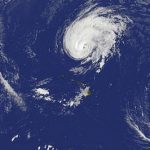It seems like someone flipped the storm off switch in the Central and Eastern Pacific basins. ADVERTISING It seems like someone flipped the storm off switch in the Central and Eastern Pacific basins. However, meteorologists say, the threat of a
It seems like someone flipped the storm off switch in the Central and Eastern Pacific basins.
However, meteorologists say, the threat of a hurricane could be far from over despite the season’s ending slated for Nov. 30.
And what a season it’s been already.
The last named storm to impact the basin was Olaf, which peaked as a Category 4 hurricane packing 150 mph winds as it entered the Central Pacific on Oct. 20 before tracking north-northeast and dissipating.
Preceding Olaf were 14 other named storms during a record-breaking season in the Central Pacific basin.
“We have little variations within the season that affect how active we are so that’s why you may have noticed a lot of the activity came in bursts having two or three cyclones in succession and then it got quiet again,” said National Weather Service Meteorologist John Bravender. “We’ve gone into a low point in that cycle, and we are also getting toward the end of the season where it traditionally gets quieter and slower.”
Forecasters had called for an above-normal season with five to eight tropical cyclones expected to pass through the basin. The most active season prior to 2015 occurred in 1992 with 11 storms; the same year Hurricane Iniki slammed Kauai.
The Central Pacific and Eastern Pacific hurricane seasons officially ends Nov. 30, but with warmer waters stretching from Hawaii to North America, there’s a good chance of seeing out-of-season formation of tropical cyclones — a category that includes tropical depressions, tropical storms and hurricanes.
“With the warmer water that we have tropical cyclones will still be a concern, but there’s nothing on the horizon (right now),” Bravender said.
Waters surrounding the Big Island are about 81 to 82 degrees, which is about two to three degrees above normal, he said. Above normal water temperatures are also being observed in the Central Pacific and Eastern Pacific basin. Temperatures within the Intertropical Convergence Zone, which is where many of the storms that have impacted our basin formed, temperatures range from 82 to 84 degrees. Water temperatures of at least 80 degrees are known to fuel convection and storms.
“With the waters warmer than normal, this is one of those years for people to be on the lookout for an out of season cyclone,” he said. “Warmer than normal water is probably one of the main guiding issues that would help stretch out the hurricane season because there’s more energy available for storms to develop.”
The warmer ocean waters are a part of the phenomena known as El Nino, Bravendar said. Reduced wind shear is also a component of El Nino, and the two combined often result in increased storm activity.
“It is still definitely El Nino,” he said. “We’re expecting (El Nino) to go through the winter.”
Should a storm form out of season, it would be added to the count of the record-breaking 2015 season. Since June 1, the official start of hurricane season in the Central Pacific, 15 storms have impacted the basin, which spans from 140 degrees west longitude to the International Dateline. Forecasters had called for an above-normal season with five to eight tropical cyclones expected to pass through the basin.
Though not a common occurrence, storms have formed outside the June 1 to Nov. 30 season. The last time was Tropical Storm Omeka in mid-December 2010. Since 1960, when the world’s first meteorological satellite was launched, other occurrences were recorded in early June 2001, December 1997, January and March of 1992, April 1990, twice in June 1978, and January 1971.
“It’s scary,” said Kailua-Kona resident Kahili Ezzo on the potential for an extended season. “I didn’t even realize it could go longer, that the season could be extended. They always say June to November.”
But Janelle Marion said she is somewhat prepared with items like a radio, flashlights, matches, candles, canned food and water should anything happen.
“I’ve never experienced it. We always have the storms and hurricanes, but we never get hit. Some people are like ‘you’re silly’ (for preparing), but you can never underestimate nature,” she said. “I fell I am semi-prepared.”
Get more hurricane-related content, including preparation tips, evacuation info and daily tropical weather updates, on our hurricane season page, sponsored by Clark Realty, at www.westhawaiitoday.com/hurricane-season-2015.






